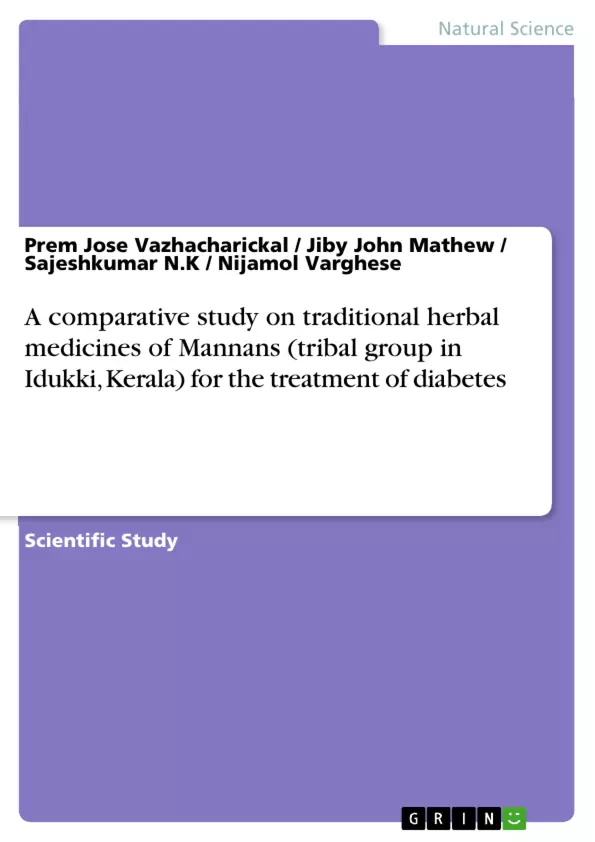Diabetes is a complex metabolic disorder resulting from either insulin insufficiency or insulin dysfunction. Diabetes mellitus affects most of the people in both developed and developing countries. The treatment of diabetes with synthetic drugs is costly and chances of side effects are high. Phytomedicine has been used since ancient times in various parts of the world where access to modern medicine is limited. Medicinal plants and phytoconstituents play an important role in the management of diabetes mellitus especially in developing countries where resources are meagre.
Phytochemicals identified from medicinal plants present an exciting opportunity for the development of new types of therapeutics for diabetes mellitus. Most prevalent among phytochemical groups are the alkaloids, glycosides, polysaccharides, and phenolics such as flavonoids, terpenoids and steroids.
This study aims to provide a comparative information about various plants used for antidiabetes treatment in a trial community (Mannans) and their constituents, which have been shown to display potent hypoglycemic activity. The current study was focused on four plants named Tinospora cordifolia, Ensete superbum, Coccinia grandis wild and Apama siliquosa Lam. which is locally known as Amruthu, Kalluvazha, Kattukoval, and Alpam respectively.
The plant parts such as seed, leaves, stem and bark were used by the local people. The plant materials prepared as decoction, infusion, aqueous extracts in milk or honey were used for the treatment of diabetes. The plants that are being used by the local people of the study area have been isolated from plants for the treatment of diabetes. The efficacy of these ethnomedicinal plants needs to be subjected to pharmacological validation. it was found that Coccinia grandis was more efficient than the other plants. Some antidiabetic plants may exert their action by stimulating the function or number of beta-cells and thus increasing insulin release. The study highlighted the central role of traditional herbal medicine for the treatment of diabetes in tribal community. Ethnobotanical survey is most useful for scientists, research scholars and scientific companies for further studies on isolation and identification of active compounds that can be formulated into antidiabetic drugs.
Inhaltsverzeichnis (Table of Contents)
- A comparative study on traditional herbal medicines of Mannans (tribal group in Idukki, Kerala) for the treatment of diabetes
- Abstract
- Introduction
- Taxonomical classification Tinospora cordifolia (plant 1)
- Taxonomical classification Ensete superbum (plant 2)
- Taxonomical classification- Coccinia grandis (plant 3)
- Taxonomical classification- Apama siliquosa Lam. (plant 4)
- Review of literature
- Materials and methods
- Plant materials
- Sample collection
- Preparation of extracts
- Phytochemical screening
- Determination of changes in the glucose level by Anthrone method
- Determination of changes in the glucose level by Benedict test
- Statistical analysis
- Results and discussion
- Conclusions
- Acknowledgements
- References
Zielsetzung und Themenschwerpunkte (Objectives and Key Themes)
This study aims to investigate the efficacy of traditional herbal medicines used by the Mannans tribal group in Idukki, Kerala, for the treatment of diabetes. The research focuses on four specific plant species: Tinospora cordifolia, Ensete superbum, Coccinia grandis, and Apama siliquosa Lam. The study examines the phytochemical properties of these plants and their potential to reduce glucose levels.
- Ethnobotanical knowledge and traditional medicine practices of the Mannans tribe
- Phytochemical analysis of selected medicinal plants
- Antidiabetic potential of traditional herbal medicines
- Scientific validation of traditional knowledge
- Contribution to the development of natural remedies for diabetes
Zusammenfassung der Kapitel (Chapter Summaries)
- Introduction: This chapter introduces the study's background and rationale, highlighting the prevalence of diabetes and the importance of exploring traditional medicinal practices for potential treatments. It provides a detailed description of the four selected plant species, including their botanical classification and traditional uses.
- Review of literature: This chapter presents a comprehensive review of existing scientific literature related to the antidiabetic properties of the selected plant species. It discusses the various phytochemicals present in these plants and their potential mechanisms of action in regulating glucose levels.
- Materials and methods: This chapter outlines the methodology employed in the study, including plant material collection, extraction procedures, phytochemical screening techniques, and glucose level determination methods. It also describes the statistical analysis used to interpret the results.
- Results and discussion: This chapter presents the findings of the study, including the phytochemical composition of the extracts and the effects of these extracts on glucose levels. It analyzes the results and discusses their implications for the antidiabetic potential of the studied plants.
Schlüsselwörter (Keywords)
Traditional herbal medicines, Mannans tribe, Idukki, Kerala, diabetes, Tinospora cordifolia, Ensete superbum, Coccinia grandis, Apama siliquosa Lam., phytochemical analysis, antidiabetic activity, glucose levels, ethnobotany, natural remedies.
- Citar trabajo
- Prem Jose Vazhacharickal (Autor), Jiby John Mathew (Autor), Sajeshkumar N.K (Autor), Nijamol Varghese (Autor), 2016, A comparative study on traditional herbal medicines of Mannans (tribal group in Idukki, Kerala) for the treatment of diabetes, Múnich, GRIN Verlag, https://www.grin.com/document/351314



